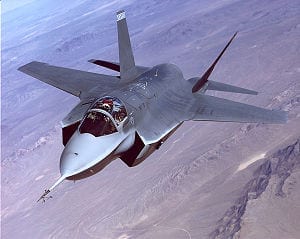SENIOR serving officers in any country’s armed forces tend to shun public controversy.
But Admiral Jonathan Greenert, America’s chief of naval operations, has stoked it in the latest issue of a specialist journal. His article appeared to question the value of the stealth technologies that underpin the biggest weapons project in history, the vast and costly F-35 Joint Strike Fighter programme.
That is controversial enough: the F-35 is the Pentagon’s pride, exemplifying America’s technological lead and military supremacy. But the admiral’s argument, outlined in Proceedings, published by the United States Naval Institute, also has a wider theme. Military procurement is too focused on building ever-costlier new ships and aircraft of complex design, with built-in capabilities to meet specific threats. Instead of procurement being “platform-centric”, he wants it to be “payload-centric”: highly adaptable platforms able to carry weapons and sensors that can be added or removed, depending on the mission or on technological progress.
The “luxury-car” platforms designed in the last days of the cold war (and which still dominate much military procurement) have not adapted well to changes in security and technology, he says. Such platforms must always carry the sophisticated equipment to defeat a sophisticated foe. Yet much of this may be irrelevant to the navy’s typical missions in the past 20 years: counter-terrorism, anti-piracy, mine-clearing, maritime patrolling and carrier operations in support of counter-insurgency campaigns in Iraq and Afghanistan.
Given the cost of building new platforms and the need to keep them in service for 30 to 50 years or even longer, Admiral Greenert wants them to be more like “trucks”: with plenty of space and power to accommodate different payloads. Some of the Pentagon’s oldest platforms have turned out to be much better trucks than their successors.
Because of its sheer size, its reserve electrical power and its small number of integral systems, at least compared with newer aircraft-carriers, the 50-year-old USS Enterprise has proved more adaptable than modern, densely packed designs. Unlike them, it has the space, storage and power-generating capacity to carry new aircraft types and new systems.
The same is true of the stalwart B-52 bomber. It first flew 60 years ago. It is now expected to stay in service until 2045. Conceived as a strategic bomber after the second world war, it has been recast many times. It is now proving to be a cost-effective platform for the latest precision-guided “stand-off” weapons (meaning those fired from afar). It is also more dependable than any of its more advanced successors.
Another advantage of high-tech payloads over platforms stems from Moore’s law: the doubling of computer-chip speed every two years or less. This embarrasses military planners. Even their latest and fabulously expensive equipment often lacks the processing power of cheap consumer gadgets. It takes at least 15 years to bring a new ship or aircraft from design to completion. That can be eight or more cycles of Moore’s law.
via The Economist
The Latest Streaming News: new military thinking updated minute-by-minute
Bookmark this page and come back often
Latest NEWS
Latest VIDEO








